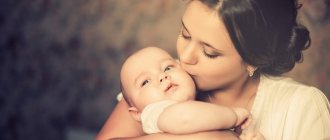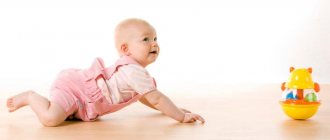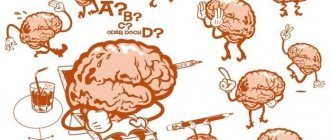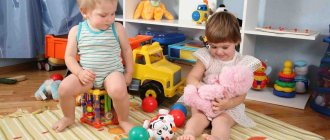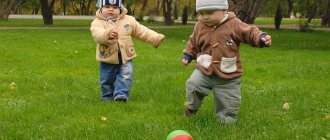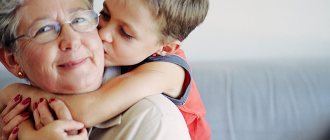Newborn crisis
The process of birth is a difficult, turning point in the life of a child. Psychologists call this period the neonatal crisis.
Causes of the neonatal crisis: - Physiological (being born, the child is physically separated from the mother. He finds himself in completely different conditions: cold, bright light, an air environment that requires a different type of breathing, the need to change the type of nutrition). — Psychological (the psyche of a newborn child is a set of innate unconditioned reflexes that help the child in the first hours of his life). What unconditioned reflexes does a newborn have? These are, first of all, breathing and sucking reflexes, protective and orientation reflexes. Some reflexes are atavistic (“catching”) - they are received from animal ancestors, are useless for the child and soon disappear. The child sleeps most of the time.
Psychological characteristics of the newborn period
The child has sensitivity: distinguishes salty, bitter, sweet taste; reacts to sound stimuli. Important events in the mental life of a child - the emergence of auditory and visual concentration
.
Auditory concentration appears at 2-3 weeks. A sharp sound, for example, a door slamming, causes a cessation of movements, the child freezes and becomes silent. Later, at 3-4 weeks, the same reaction occurs to a person’s voice. At this time, the child not only focuses on the sound, but also turns his head towards its source. Visual concentration, which appears at 3-5 weeks, is externally manifested in the same way: the child freezes and holds his gaze (of course, not for long) on a bright object. A newborn, having acquired the ability to respond to the voice of the mother caring for him, to see her face, establishes emotional connections with her. At about 1 month, the baby, seeing his mother, fixes his gaze on her face, throws up his arms, quickly moves his legs, makes loud noises and begins to smile. This violent emotional reaction has been called the “animation complex.”
The animation complex, which includes a truly human characteristic - a smile - marks the emergence of the first social need - the need for communication. And the development of a child’s need for communication means that in his mental development he moves from newbornness to infancy itself.
Question 2: Newborn reflexes
Newbornhood is the only period in a person’s life when natural, instinctive forms of behavior can still be observed in their pure form. Therefore, it is possible to understand what nature gives to a child by studying this particular age.
A baby is born with a certain supply of innate unconditioned reflexes, i.e. automatic, involuntary responses to certain external stimuli. And although his nervous system is still far from formed, it is ready to adapt the body to external conditions.
Among the innate reflexes of a newborn there are functional
, which are absolutely necessary for his survival in the outside world, helping the child adapt to new living conditions. So, immediately after birth, reflexes are activated that ensure breathing and blood circulation. This group also includes the so-called protective reflexes, which protect the body from dangerous and too strong influences. Thus, severe skin irritation (for example, an injection) causes the child to withdraw his arms or legs; a sharp increase in light brightness causes constriction of the pupil (pupillary reflex); In response to a flicker of light or a puff of air, the baby squints or closes his eyes (blink reflex).
These reflexes are essential for physical survival and persist throughout a person's life.
The most important functional reflex for a newborn is the sucking reflex. If you touch an object (for example, a finger) to the baby's mouth, he immediately begins to suck on it. And if you touch his cheek, he will turn his head towards the stimulus and, with his mouth open, will look for his mother’s breast. This turns on the search reflex. These reflexes ensure that the child is ready for a new type of nutrition.
12 pp., 5894 words
Psychological climate in a family raising a child with special needs...
... a child with special needs of psychophysical development. Research objectives: ) carry out a theoretical analysis of the literature on the research problem; ) consider the characteristics of the emotional state of parents raising children with special needs of psychophysical development; ... a favorable family climate is marital relations. Living together requires spouses to be willing to compromise, to be able to...
However, not all reflexes of a newborn have vital adaptive significance. Among them there are those who do not play any role in the child’s life. The most striking example of this is the so-called Robinson reflex (or grasping reflex).
Touching a baby's palm produces a grasping reaction that is surprisingly strong for a newborn. For example, if you touch his palms with your fingers, he will grab them so tightly that he can hang, holding on to them, like a monkey. This also includes the stepping reflex - if the baby’s foot touches any surface, he begins to make stepping movements with both legs, as if he were walking. Reflexes that are equally useless for the life of a newborn include the crawling reflex (touching the soles of the feet causes a reflex repulsion); hand-throwing reflex (or Moro reflex - if the baby is in danger of falling or in response to a strong sound, he sharply raises his hands up and quickly lowers them, while his palms seem ready to grab something); cervical-tonic reflex - when the head of a child lying on his back is turned to the side, he extends the arm and leg on the side of the body where the head is turned and bends the opposite arm and leg, which resembles a fencer's pose. Recently, the swimming reflex of a newborn has been discovered: if he is lowered into water, he will not drown, but will flounder and stay on the water.
All these are so-called atavistic reflexes. They represent the inheritance received by the child from his animal ancestors. It is characteristic that most of them fade away already in the first half of life. For example, the Robinson reflex weakens significantly by the fourth month of life, before a purposeful act of grasping occurs. The step reflex disappears at 3–4 months, long before the child begins to walk. The crawling reflex when resting on the soles is also not the basis for independent movement in space. As observations have shown, infant crawling begins not with pushing off with the legs, but with movements of the arms. Unconditioned reflexes of newborns do not by themselves ensure the emergence of human forms of behavior. In contrast, a set of unconditioned reflexes of young animals is a necessary natural basis for the behavior of an adult with active protective, hunting, maternal and other forms of behavior necessary for its normal existence.
At the same time, these unconditioned reflexes of the newborn can be included in other, more complex and purposeful forms of behavior of the child. For example, the sucking reflex, since it is constantly exercised in a situation of interaction with the mother, at 2–3 months. turns into a purposeful and regulated action of the infant. The child stops sucking everything, he begins to regulate the rhythm and intensity of sucking. It can stop when you are full or start when you see a pacifier or bottle. The same goes for the grasping, stepping or swimming reflex. If they are constantly trained and included in a situation of interaction with an adult, these movements can be preserved and become part of more complex actions (walking, grasping and holding an object, etc.).
9 pages, 4066 words
Classification of brain tumors in children
... classifications are based on this principle. Brain tumors diagnosed in children in the first years of life have a central location, i.e. most often affect the third ventricle, hypothalamus, ... chiasma of the optic nerves, midbrain, pons, cerebellum and fourth ventricle. Despite...
However, these reflexes themselves will never develop into human forms of behavior, which are formed on a completely different, non-reflexive basis.
A newborn has another group of reflexes, which, although they have no vital significance, do not fade with age, but, on the contrary, become stronger. These are indicative reflexes
, aimed at contact with external influences. It has been established that already on the first day of life, a strong light source causes the baby’s head to turn: in the children’s room of a maternity hospital on a sunny day, the heads of most newborns are turned towards the light, like sunflowers. The newborn also reacts to a strong sound by turning its head towards its source. Unconditioned orienting reflexes are the basis of the need for impressions, which manifests itself already in the first days of life.
By the end of the first month of life, the first conditioned reflexes
. In particular, the baby begins to respond to the feeding position: as soon as he finds himself in a certain position on the mother's lap, he begins to suck.
Emotional communication with an adult as the leading activity of an infant
The leading activity of infancy is emotional communication with adults. A child at this age is weak and completely helpless. Although, upon being born, he was physically separated from his mother, he was still biologically connected to her. He cannot satisfy any of his needs on his own: he is fed, bathed, dressed in dry and clean clothes, moved in space, and his health is monitored. And finally, they communicate with him. Such helplessness and complete dependence on an adult constitute the specificity of the social situation of an infant’s development. The need for communication in a child appears early, at about 1 month, after the neonatal crisis (according to some sources, at 2 months). The revival complex upon the appearance of the mother (or another loved one caring for the child) indicates the emergence of a need for communication, which should be satisfied as fully as possible. Direct emotional communication with an adult creates a joyful mood in a child and increases his activity, which becomes a necessary basis for the development of his movements, perception, thinking, and speech. What happens if the need for communication is not satisfied or is not satisfied enough? Children who end up in a hospital or orphanage are lagging behind in mental development. Until 9-10 months, they maintain a meaningless, indifferent gaze directed upward, move little, feel their body or clothes and do not try to grab toys that catch their eye. They are lethargic, apathetic, and have no interest in their surroundings. They will have speech very late. Moreover, even with good hygienic care, children lag behind in their physical development. These severe consequences of lack of communication in infancy are called hospitalism.
Psychological and pedagogical conditions for the development of children during the neonatal period and infancy
Psychological and pedagogical conditions for the development of children during the neonatal period and infancy
The process of birth is a difficult, turning point in the life of a child. Psychologists call this period the neonatal crisis.
Causes of the neonatal crisis: - Physiological (being born, the child is physically separated from the mother. He finds himself in completely different conditions: cold, bright light, an air environment that requires a different type of breathing, the need to change the type of nutrition). — Psychological (the psyche of a newborn child is a set of innate unconditioned reflexes that help the child in the first hours of his life). What unconditioned reflexes does a newborn have? These are, first of all, breathing and sucking reflexes, protective and orientation reflexes. Some reflexes are atavistic (“catching”) - they are received from animal ancestors, are useless for the child and soon disappear. The child sleeps most of the time.
The child has sensitivity: distinguishes salty, bitter, sweet taste; reacts to sound stimuli. Important events in the mental life of a child - the emergence of auditory and visual concentration
.
Auditory concentration appears at 2-3 weeks. A sharp sound, for example, a door slamming, causes a cessation of movements, the child freezes and becomes silent. Later, at 3-4 weeks, the same reaction occurs to a person’s voice. At this time, the child not only focuses on the sound, but also turns his head towards its source. Visual concentration, which appears at 3-5 weeks, is externally manifested in the same way: the child freezes and holds his gaze (of course, not for long) on a bright object. A newborn, having acquired the ability to respond to the voice of the mother caring for him, to see her face, establishes emotional connections with her. At about 1 month, the baby, seeing his mother, fixes his gaze on her face, throws up his arms, quickly moves his legs, makes loud noises and begins to smile. Neoplasm.
This violent emotional reaction has been called
the “animation complex.”
The animation complex, which includes a truly human characteristic - a smile - marks the emergence of the first social need - the need for communication.
And the development of a child’s need for communication means that in his mental development he moves from newbornness to infancy itself. 2. The leading activity
of a newborn and infancy is emotional communication with an adult.
A child at this age is weak and completely helpless. Although, upon being born, he was physically separated from his mother, he was still biologically connected to her. He cannot satisfy any of his needs on his own: he is fed, bathed, dressed in dry and clean clothes, moved in space, and his health is monitored. And finally, they communicate with him. Such helplessness and complete dependence on an adult constitute the specificity of the social situation of an infant’s development. The need for communication in a child appears early, at about 1 month, after the neonatal crisis (according to some sources, at 2 months). The revival complex upon the appearance of the mother (or another loved one caring for the child) indicates the emergence of a need for communication, which should be satisfied as fully as possible. Direct emotional communication with an adult creates a joyful mood in a child and increases his activity, which becomes a necessary basis for the development of his movements, perception, thinking, and speech. What happens if the need for communication is not satisfied or is not satisfied enough? Children who end up in a hospital or orphanage are lagging behind in mental development. Until 9-10 months, they maintain a meaningless, indifferent gaze directed upward, move little, feel their body or clothes and do not try to grab toys that catch their eye. They are lethargic, apathetic, and have no interest in their surroundings. They will have speech very late. Moreover, even with good hygienic care, children lag behind in their physical development. These severe consequences of lack of communication in infancy are called hospitalism.
The beginning of infancy coincides with the end of the neonatal crisis. The turning point is between 2 and 3 months. child's life. So, infancy itself can be divided into 2 periods.
1. from 2 – 3 months. up to 6 months
2. from 6 to 12 months.
At this time, we can observe new manifestations in all areas. The strongest drop in the daily amount of sleep curve has ended, the maximum daily amount of negative reactions has been left behind, food intake is now not carried out with such greed, so the child interrupts eating for a second, opening his eyes. There are all conditions for activities beyond sleep, feeding and crying. Internal interference with sleep and startling when exposed to external stimuli are much less common. But the child’s activities become more varied and longer-lasting.
As new forms of behavior at this time, playful experimentation, babbling, the first active activity of the sensory organs, the first active reaction to position, the first coordination of two simultaneously operating organs, the first social reactions are added - expressive movement associated with functional pleasure and surprise.
Everything indicates that the passivity with which the newborn treated the world gave way to receptive interest. Henri Vallon also notes that with the 2nd month, a new period opens in the child’s development, in which motor skills of a purely affective type gradually give way to activity approaching sensorimotor in nature. At the same time, the face takes on an expression of attentiveness and readiness to perceive external impressions. The child begins to be absorbed by visual impressions, and soon he begins to listen, although at first only to the sounds made by himself. He reaches out to objects, touches them with his hands, lips and tongue. At this time, the makings of manual activity, which is so important for all mental development, develop.
For the child, the outside world appears. This new attitude to reality marks the onset of the infant period, or rather, its first stage.
The second stage of infancy is also marked by drastic changes in the child’s attitude to the outside world. We observe a turning point of the same significance between the 5th and 6th months. From this time on, sleep and wakefulness occupy the same amount of time during the day. Of the new forms of behavior by this time, by the way, the first confident defensive movements, confident grasping, the first animated gusts of joy, a cry due to a failed intentional movement are observed, it is also possible that the first desire, experimental actions, social reactions to peers, searches lost toys, i.e. active interest in the environment.
It should be noted that in the development of a child in a year there is such a leap that does not occur in the rest of his life.
Physical development of the baby
At 3-4 months
The child begins to reach for objects with his hand. If a two-month-old holds an object placed in his hand for up to 10 seconds, then a three-month-old holds the object for 20 seconds. A normally developing child will learn to grasp an object with his hand only by 5-5.5 months; sits with support. His movements are smooth and free. Congenital muscle tension - muscle hypertension - weakens. By three months, the rhythm of sleep and wakefulness is finally established. The baby is awake up to five to six hours a day.
By five months, the baby is already turning over from his back to his tummy. He tries to sit down himself.
At 5 months
he already grasps stationary objects with his hand.
At 6 months
Physiological muscle hypertension finally disappears; the child sits on a chair with support and can grab moving, swinging objects.
At 7 months
he sits without support.
IN 8
sits down without assistance. Sit confidently. Crawling prepared him for sitting. The ability to sit down, sit and at the same time use your hands freely is the most important stage in the development of a child up to one year old. And let us emphasize again: the baby sat down because he had matured mentally.
Aged about 9
months, the baby stands with support, crawls on his stomach, and at
10 months
he walks with support and crawls, leaning on his hands and knees. He crawled not so much because he had strengthened his back and limbs, but because he was mentally ripe for this, that he must realize the instinct of freedom. Mentally full-fledged crawled because for the further development of the mind he needs to master a new space. He crawled towards a new toy, he crawled for his mind. A mentally retarded person, although physically strong, will not crawl, because he has no need to. Naturally, crawling improves the child physically. Crawling should precede independent sitting, as it strengthens the muscles of the back, torso, and limbs. And when a child who has learned to crawl sits down, his back will not arch helplessly, threatening curvature of the spine and disturbances in the development of internal organs.
IN 11
months the child already stands without support, at
12
he walks holding the hand of an adult, and at
13
he walks independently.
Skeletal ossification
. At 6-7 months the first teeth appear. The large fontanel is 1.4 -1.9 at nine - ten months, 0.5 -1.0 cm at eleven months and can be barely felt with the tip of the index finger.
Digestive system:
From five to six months, the child switches to five feedings with breaks of four hours, stays awake for up to two and a half hours at a time, sleeps three times during the day for one and a half to two hours and sleeps at night as usual, from one and a half months until school - 10 -11 hours.
By 1 year of age, regurgitation stops.
V.S.:
Kidney function is normalized. However, the Child does not control the excretory function.
N.S.:
And if a child is born already having a quarter of the weight of an adult’s brain (300 - 400 g), then in the first year of life the weight of his brain will double, and by the age of three it will triple. The remaining fourth part of the brain matures by the age of 20 (the adult brain weighs 1200-1600 g). Thus, in the first year of life, a child’s brain increases by more than a gram every day!
The weight of the cerebellum increases two and a half times, and this means that the baby’s movements have reached high perfection - he is very, very coordinated in space and is ready to go.
Development of infant mental functions
Feeling:
In the first half of life, an extremely intensive development of sensory mechanisms and elementary forms of future orientation reactions occurs: concentration, tracking, circular movements. Visual concentration, i.e. the ability to fix the gaze on an object appears in the second month of life. By the end of it, the child can independently move his gaze from one object to another.
A fairly good level of development of eye movements can be noted in a child by about three months of age. Children's eye movements develop faster and become more perfect when there are bright, attractive objects in their field of vision, as well as people making a variety of movements that the child can observe.
From about the second month of life, the child has the ability to distinguish the simplest colors, and in the third or fourth months - the shapes of objects.
Auditory perception develops. At 4 months reactions to the mother’s voice appear (smile). At 6 months They begin to worry if they hear their mother’s voice, but do not see her. By 10 months, hearing the mother's recorded voice, will look at the mother.
Tactile sensitivity develops, which is important for the occurrence of the act of grasping and examining an object.
At about 5 months, a turning point occurs in the child’s development. It is associated with the emergence of the act of grasping - the first organized, directed action. This is a real revolution in the development of a child in the first year of life. The act of grasping is prepared by the entire life that precedes it. It is organized by an adult and is born as a joint activity between a child and an adult, but this is usually not noticed.
The act of grasping is a behavioral act, and behavior requires the mandatory participation of orientation. Therefore, in order for grasping to occur, it is necessary that the hand turns into an organ of touch, so that it “opens up.” Initially, the child’s hand is clenched into a fist. Until the hand has become an organ of perception, it cannot become an organ of grasping. Grasping is carried out under visual control: the child examines his hands, watches how the hand approaches the object.
First, the child grabs objects that happen to be at hand that she encounters along her natural path. Then the movements of the hand become more purposeful and controlled by the image of a visually perceived object located at some distance from the child. The baby catches it, manipulates it, paying attention to the properties of this object. He begins to reproduce the most striking and attractive properties of objects with the help of repeated movements. For example, he shakes a rattle in order to reproduce the sound it makes; throws an object on the floor in order to trace the trajectory of its fall; knocks one object against another in order to hear the characteristic sound again. After 10 months, adaptation of the arm and hand is carried out in advance, even before touching the object, only on the basis of its visually perceived image. This indicates that the image of the object began to actively control and regulate the movements of the hands, i.e. that the child has developed sensorimotor coordination.
Thinking:
In the form of sensorimotor intelligence.
The act of grasping is of extreme importance for the mental development of a child. The emergence of objective perception is associated with it. When a stimulus impacts the eye, there is no image yet. An image arises when there is practical, effective contact between the image and the object. Thanks to grasping, space arises, this space of an outstretched arm, its extent is small, but the object breaks out of the previous scheme. Before this, the perception of an object was carried out through the mouth; now, when the child reaches for an object, the mouth closes. Thanks to the act of grasping, the hand develops: the opposition of the thumb arises, which serves as one of the generic differences between man and his closest ape ancestors.
Based on the act of grasping, the possibilities of manipulating an object expand, and at the age of 4 to 7 months, effective actions arise: simply moving an object, shifting it, extracting sounds from it. At the age of 7-10 months, correlated actions are formed: the child can manipulate two objects at the same time, moving them away from himself and correlating them with each other: the child takes the object away from himself, bringing it closer to another object in order to put it, stand it or string it on it. By the end of infancy (from 10-11 to 14 months), a stage of functional actions arises: these are more advanced actions of stringing, opening, inserting, but if earlier the child performed the action in the same way shown to him and on the same objects, now he tries reproduce the action on all possible objects.
Grasping, directing towards an object, stimulates the occurrence of sitting. When a child sits down, other objects open up in front of him. Objects appear that cannot be touched. The law of the child’s advance acquaintance with the world appears again.
Speech:
The child's vocal reactions develop. The first calls arise - attempts to attract an adult with the help of the voice, which indicates the restructuring of vocal reactions into behavioral acts.
In the first months of life, the baby develops an increased interest in human speech,
it stands out in his perception from the world of other sounds.
At the age of about 1 month, the newborn begins to pronounce some simple sounds
like a-a, oo-oo, uh.
Around two to four months from birth, hooting appears,
then, at 4-6 months,
humming occurs, followed by the repetition of simple syllables.
In the second half of life, babbling appears, and at 9-10 months
the first words are noticed in the baby’s speech.
At 6-6.5 months, the child associates the perceived object with
its name.
Around 8 months, a clear orienting-exploratory reaction appears in response to the naming of an object: turning the head in its direction, moving in the direction of the object, grasping it with hands, examining it, manipulating it. At about 10 months, along with emotional, gestural and verbal communication, a new form of communication appears in the child and adult - objective communication. In response to an adult naming an object, the child takes it and hands it to the adult.
From seven months of life, intonation ,
associated with an appeal or request. From ten months onwards, vocal signs of persistence appear.
By the end of the first year of life, the child accurately understands, on average, about 10-20 words and reacts to them in a certain way. In response to an adult pronouncing the name of an object, for example, he turns his head towards this object and actively looks for it.
Memory:
The ability to remember and store images in memory in their primary forms also develops in an infant during the first year of life. Until 3-4 months of age, a child is apparently able to retain the image of a perceived object for no more than one second. After 3-4 months, the time the image is preserved increases, the child acquires the ability to recognize the mother’s face and voice at any time of the day. In the second month of life, the baby reacts to people in a special way, highlighting and distinguishing them from surrounding objects.
At 8-12 months, he identifies objects in the visual field, and recognizes them not only as a whole, but also in individual parts. At this time, an active search for objects that suddenly disappeared from view begins, which indicates that the child retains the image of the object in long-term memory, isolates it from the situation for a long time and relates it to it, i.e. records the objective connections that exist between objects. (associative memory)
Social situation of infant development.
The life and activities of the child are, as it were, woven into the life and activities of the adult caring for him. In general, this is a situation of comfort, and the central element of this comfort is an adult.
The social situation of the inextricable unity of a child and an adult contains a contradiction:
the child needs the adult as much as possible and, at the same time, does not have specific means of influencing him. This contradiction is resolved throughout the entire period of infancy. The resolution of this contradiction leads to the destruction of the social development situation that gave rise to it.
The social situation of the child’s common life with his mother leads to the emergence of a new type of activity - direct emotional communication
child and mother. As studies by D.B. have shown. Elkonin and M.I. Lisina, a specific feature of this type of activity is that the subject of this activity is another person. But if the subject of the activity is another person, then this activity is the essence of communication. Communication during this period should be emotionally positive. Research has shown that a lack of communication during this period has a negative impact. Thus, after the Second World War, the concept of “hospitalism” entered psychology, with the help of which the mental development of children who lost their parents and ended up in hospitals or orphanages was described.
Many studies indicate that under conditions of hospitalization, pre-speech and speech development suffers; separation from the mother affects the development of cognitive functions and the emotional development of the child. That is why the beginning of mental life consists in the formation in a child of a specifically human need for communication.
The main, leading type of child activity in
the first period of infancy is
emotionally direct communication.
The child reaches out to an object that is attractive, but it can only be obtained with the help of an adult. Thanks to this, communication takes on a different character; it becomes communication about objects. M.I. Lisina called it situational and businesslike.
Starting from the second half of life, the child no longer agrees to simply “exchange affection with an adult.” He now needs an adult to “collaborate” with him in business, organize it, help in difficult times, encourage him in case of failure, praise him for his achievements. Changing the subject of communication requires new means and ways of influencing an adult. A pointing gesture appears from a hand extended to an unattainable object. It is already objectively related and contains the germ of a word.
The nine-month-old already knows his name and responds with animated movements to the call of an adult. He is already kind or “evil”, energetic or passive, persistent or compliant, calm or crybaby, fearless or cautious, or even timid, sociable or on his own.
And the baby reacts to strangers in a new way. “While 3-4 month old children smile and perk up when any adult talks to them, 5-6 month old children,” writes D. B. Elkonin, “if a stranger comes up to them and starts talking, instead of in order to immediately smile, they look at him for a long time and with concentration, and then either smile or turn away, and sometimes they can cry loudly.”
Crisis of the first year of life and major neoplasms.
The crisis of the first year of life is the transition from infancy to early childhood. The fact that a child cannot independently get an object or ask for it leads to the fact that he becomes capricious.
By 9 months (beginning of the 1st year crisis), the child stands on his feet and begins to walk. As emphasized by D.B. Elkonin, the main thing in the act of walking is not only that the child’s space expands, but also that the child separates himself from the adult. For the first time, the unified social situation “We” is fragmented; now it is not the mother who leads the child, but the child who leads the mother wherever he wants. Walking is the first major new development of infancy, marking a break in the old developmental situation.
The second main new development of this age is the appearance of the first word. The peculiarity of the first words is that they are in the nature of pointing gestures. Walking and enriching object actions require speech that would satisfy communication about objects. Speech, like all new developments of age, is transitional in nature. This is an autonomous, situational, emotionally charged speech, understandable only to those close to you. This speech is specific in its structure, consisting of fragments of words. Researchers call it "nanny language." But whatever this speech may be, it represents a new quality that can serve as a criterion that the old social situation of the child’s development has disintegrated. Where there was unity, there became two: an adult and a child. Between them a new content grew - objective activity.
Orientation towards the assessment of an adult is a qualitative new formation that occurs during the crisis period of 1 year of life.
10
The main lines of a child’s mental development
Sensory development: visual concentration, which appeared at the newborn stage, is improving. After the second month, concentration becomes quite long; by 3 months, its duration reaches 7-8 minutes. At this age, the child determines the shape of objects and reacts to color. The child can track moving objects. At 4 months, he not only sees, but actively looks: he reacts to what he sees, moves and squeals. A child's cognitive development is facilitated by the variety of impressions he receives. Adults caring for a child must satisfy his need for new experiences.
, trying to ensure that the environment around him was not monotonous and uninteresting. The cognitive development (primarily the development of perception) of infants living in a monotonous environment turns out to be somewhat slower than the development of those who receive many new experiences.
Development of movements and actions:
Time of occurrence of movements
| Motor development | |
| 1 month | Raises chin |
| 2 months | Raises the chest |
| 3 months | Reaches for an object, but usually misses |
| 4 months | Sits with support |
| 5 - 6 month | Grabs objects with hand |
| 7 months | Sits without support |
| 8 months | Sits down without assistance |
| 9 months | Stands with support: crawls on stomach |
| 10 months | Crawls, leaning on hands and knees; walks holding with both hands |
| 11 months | Stands without support |
| Year | Walks holding on with one hand |
1 month - chaotic movement of the hands, fingers clenched into a fist; 2 months - clenching and unclenching fingers. An object placed in the hand is held with the entire palm for 2-3 seconds. 3 months - holds an object placed in the hand for up to 10 seconds, pulls it into the mouth. 4 months - palms are often open, hands are extended towards an object, finger movements are not differentiated. 5 months - opposes the thumb to the others, parts of the fingers dominate when grasping objects. 6-7 months - the child waves the objects he has grabbed, knocks, throws and picks them up again, bites, moves from hand to hand, etc., the movements of the fingers are differentiated. 8-9 months - takes small objects with two fingers, and large ones with the whole palm, shows his nose, eyes, waves his hand when saying goodbye, tightly squeezes the toy that is taken away. 10-11 months - manipulates objects, first functional actions
, allowing for relatively correct use of objects, imitating the actions of adults (a child rolls a car, beats a drum, brings a cup of juice to his mouth).
Speech development: Already in the revitalization complex, the child shows a special interest in the speech of an adult addressed to him. In the first half of the year, speech hearing is formed, and the child himself, with joyful animation, makes sounds, usually called humming
.
In the second half of the year, babbling appears, in which it is possible to distinguish some repeating sound combinations, most often associated with the actions of the child. Babbling is usually combined with expressive gestures. By the end of 1 year, the child understands
10-20 words spoken by adults, and he himself
pronounces
one or several of his first words that sound similar to the words of adult speech.
Question 3: Features of sensory development
How can you describe the mental life of a newborn? A newborn baby probably seems completely helpless to you. How can he understand the world if he is not even able to lift his head? But it is precisely in the first weeks of life that the child has unique sensory abilities, which after a few months will begin to fade, and by the year they will practically disappear.
Study by Bronstein and Petrov: children were observed from a few hours to 8 days old. The technique was that the newborn was presented with various stimuli, and the indicator of discrimination ability was inhibition of the sucking reflex.
The results revealed that newborns not only respond to stimuli, but are also able to distinguish their intensity.
Sounds that differ from each other by more than 1 octave are distinguished by 89% of subjects. A difference of one 1 octave is 70%, less than 1 octave is 40%.
The location of the sound on the right or left is also distinguished.
Color sensitivity: only 37% of children react to changes in color, and only extreme colors (green-red).
Taste and olfactory sensitivity are detected 1.5 hours after birth.
Tactile sensitivity is distributed unevenly: the most sensitive areas are the lips, palms, and forehead.
The child distinguishes temperature (10 degrees different from the usual temperature can lead to refusal of food).
Ψ: It is believed that the skin is the main channel of communication with the outside world during this period. Advice: if you want your baby to develop intelligence from the very first days, try to let him spend as much time naked as possible. It is especially important that the arms to the elbow and legs from the foot to the knee are open - this is where the most susceptible areas of the skin are located.
13 pages, 6323 words
The difference in popularizing the development of a healthy lifestyle among...
... urban environment .2 The main problems of the development of sports in rural areas and ways to combat them. Study of a healthy lifestyle among children and adolescents in urban and rural areas. Conclusion List of references Introduction Relevance. In accordance with the Concept of long-term socio-economic development of the Russian...
Important events in the mental life of a child - the emergence of auditory and visual concentration
. Auditory concentration appears at 2-3 weeks. Sounds cause movements to cease, the child freezes and becomes silent. Later, at 3-4 weeks, the same reaction occurs to a person’s voice. At this time, the child not only freezes, but also turns his head towards the source of the sound. Visual concentration appears at 3-5 weeks; it manifests itself in the same way: the child freezes and fixes his gaze on a bright object.
In general, mental life is associated mainly with subcortical centers, as well as with an insufficiently mature cortex. Ψ: at the time of birth, the weight of the brain is 389 g, by the age of 1 year it increases to 890 g (an increase of +501 g).
For brain development, a child needs as much stimulation as possible. This is explained by the peculiarities of the morphological structure of the NS. A newborn's sensations determine the architecture of his brain. Every new experience is reinforced through brain connections, helping to build new connections between brain cells. Under the influence of the flow of sensory sensations delivered by early life experiences, a nervous network arises, the more complex of which is unlikely to be found in the entire universe. But if the brain receives too few external impressions, “excessive” connections are eliminated, and with them future opportunities. Ψ: manifestation of this pattern in animals: in animals growing up in conditions of impoverished visual experience, the visual centers of the brain lag behind in development, the bodies of neurons are reduced, their processes are shortened and the development of pathways slows down. Children with disturbances in the functioning of their sensory organs have deviations in the characteristics of the bioelectrical activity of the brain.
Reputable brain researchers now share the view that the emotional and sensory development of the newborn child is critical to its later learning abilities [4].
The process of development of the nervous system and the brain as its part is determined by the hereditary program, as well as impressions, experiences and training received in early childhood. The most basic functions of the brain are determined genetically, in the trunk of which synapses are formed that allow the functioning of all internal organs - heart, lungs, liver, etc. Today it is estimated that of the 80,000 different genes, approximately half determine the development, formation and control of the central nervous system. This number limits the effect of heredity - further development of the brain occurs under the influence of external stimuli and learning. The hereditary program strictly determines only the order of development of brain zones, and the degree of their development is determined by the action of external stimuli.
Thus, it becomes increasingly obvious that hereditary inclinations and experience are in constant interaction. Powerful stimuli from the surrounding world, through carrier substances, can even affect the nuclei of cells and thereby influence the activity of genes.
The baby learns what abstract concepts mean through the senses. “Later” is a tense, if not anxious, time of waiting. “More” can mean super-pleasure, but also an unpleasant feeling. “Close” means clinging closely to the mother. Before a child can count, he needs "sensory understanding" to gain an understanding of extension, duration, and magnitude. This will become a prerequisite for logical thinking [12].
7 pages, 3272 words
Development of the psyche in phylogenesis. The emergence and development of consciousness...
... vertebrates develop the spinal cord and brain - the central nervous system. Simultaneously with the development of the nervous system and receptors, ... more complex perception and strong memory are improved. The emergence and development of consciousness The development of the psyche in phylogenesis led to the emergence of its highest ... is formed under the condition of human life in society (children - Mowgli have no consciousness) and besides, it ...
Later, the child will be able to connect various sensory experiences into a single complex image. But a newborn child still cannot interpret the flow of incoming information. To do this, he needs some kind of organizing force that would give meaning to his sensations. This power is nothing more than a feeling.
Emotional evaluation of new sensory sensations occurs in the limbic system of the brain. They are compared with those impressions that have already been accumulated in the cerebral cortex and, if they turn out to be new and important, they are deposited there. Based on these sensations, it becomes possible to formulate further appropriate actions. For this cycle to occur, the individual brain participants must be securely connected to each other.
Neoplasms of infancy
New formations: elementary forms of perception and thinking. First independent steps, words. An active need to understand the world around us. With the appearance of the first words, a new stage in the child’s mental development begins. Between infancy (0-1) and early childhood (1-3) there is a transition period called the “1 year crisis”
External manifestations of a crisis: a child develops affective reactions when an adult does not understand him or forbids him to do something. The child becomes restless, manifestations of independence appear. Internal causes of the crisis: the growing contradiction between the needs for knowledge of the world around us and the capabilities that the child has. Capabilities are still insufficient to meet needs. The main acquisition of the transition period is the peculiar children's speech, which L.S. Vygotsky called it autonomous. It differs significantly from adult speech; its sound sometimes resembles “adult” words, and sometimes differs sharply from them (av-av - dog, titi - clock).
